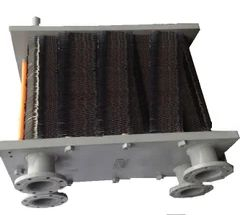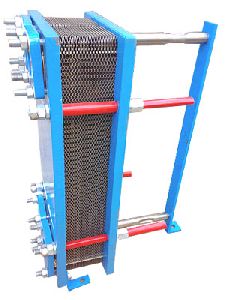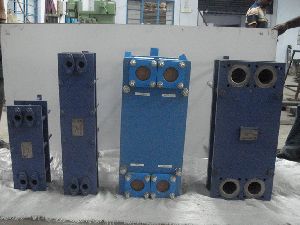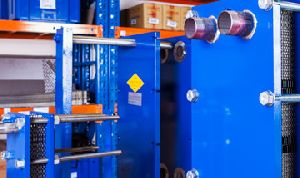
Plate Heat Exchanger
15,000 Per Piece
1 Piece (MOQ)

Plate Heat Exchanger
Get Price Quote
Looking for Plate Heat Exchanger Services Providers

Plate Heat Exchanger
Get Price Quote
10 Piece (MOQ)
Plate Coolers bolted Unique and maintenance-free – for efficient cooling The bolted plate coolers offer an economical solution for hydraulic systems and cooling circuit.s With their high cooling capacity and extremely low water consumption. The high turbulent flow of the fluid reduces the risk of soiling. Our coolers have been designed for operating pressures of 10 to 16 bar. For applications, where the medias should not get mixed, we recommend the solution with double wall plates. We can also supply you with customised solutions with switch over devices.

Plate Heat Exchangers
Get Price Quote
Plate Heat Exchangers is a type of heat exchanger that uses metal plates to transfer heat between two fluids. This is a major advantage over a conventional heat exchanger in that the fluids are exposed to a much larger surface area because the fluids spread out the plates. This facilitates the transfer of heat, and greatly increases the speed of the temperature change. It is not as common to see plate heat exchangers because they need well-sealed gaskets to prevent the fluids from escaping, although modern manufacturing processes have made them feasible.

Plate Heat Exchangers
Get Price Quote
We manufacture and supply highest quality range of plate heat exchanger using the most advanced technology for a wide series of heat transfer applications used in various industries such as chemical industry, offshore, oil and gas, petrochemicals power plants, pulp and paper, steel, zinc and aluminium, sugar, vegetable oil, breweries / distilleries, dairy / beverages and others. The difference lies at plate design, sealing technology, capacity range, product range etc. We always continue to improve our Plate heat exchanger to give total customer's satisfaction. Plate Heat Exchanger Features High heat transfer coefficients Optimized heat recovery Compact constructions No mixing of product Flexibility to change plate arrangement and to add / remove plate Easy maintenance and suitable for CIP, plate pack easily accessible. Plate Heat Exchanger A plate type heat exchanger is a type of heat exchanger that uses metal plates to transfer heat between two fluids. This has a major advantage over a conventional heat system in that the fluids are exposed to a much larger surface area because the fluids spread out over the plates. This facilitates the transfer of heat, and greatly increases the speed of the temperature change. It is not as common to see plate heat exchangers because they need well-sealed gaskets to prevent the fluids from escaping, although modern manufacturing processes have made them feasible. Plate Frame Heat Exchanger Application Plate Frame Heat Exchanger Cleaning Plate and Frame Heat Exchangers Animation Plate and Frame Heat Exchanger Approach Plate finned type Heat Exchanger Brazed Plate Heat Exchangers Plate Heat Exchanger Design The concept behind a plate heat exchanger is the use of pipes or other containment vessels to heat or cool one fluid by transferring heat between it and another fluid. In most cases, the exchanger consists of a coiled pipe containing one fluid that passes through a chamber containing another fluid. The walls of the pipe are usually made of metal, or another substance with a high thermal conductivity, to facilitate the interchange, whereas the outer casing of the larger chamber is made of a plastic or coated with thermal insulation, to discourage heat from escaping from the exchanger. The plate heat system (PHE) s was invented by Dr Richard Seligman in 1923 and revolutionized methods of indirect heating and cooling of fluids. Plate exchanger one is composed of multiple, thin, slightly-separated plates that have very large surface areas and fluid flow passages for heat transfer. This stacked-plate arrangement can be more effective, in a given space, than the shell and tube heat system. Advances in gasket and brazing technology have made the plate type heat system increasingly practical. In HVAC applications, large exchangers of this type are called plate-and-frame; when used in open loops, these heat system are normally of the gasket type to allow periodic disassembly, cleaning, and inspection. There are many types of permanently-bonded plate heat system, such as dip-brazed and vacuum-brazed plate varieties, and they are often specified for closed-loop applications such as refrigeration. Plate heat systems also differ in the types of plates that are used, and in the configurations of those plates. Some plates may be stamped with "chevron" or other patterns, where others may have machined fins and/or grooves. Liquid foods such as milk, fruit juices, beers, wines, and liquid eggs are pasteurized using plate-type. Wine and fruit juices are normally deaerated prior to pasteurization in order to remove oxygen and minimize oxidative deterioration of the products. Plate Type heat exchanger consist of a large number of thin, vertical steel plates that are clamped together in a frame. So it may called as Plate and Frame. We manufacture Plate Heat Exchanger that are used in dairy, pharma and biotechnology, beverages, brewery, chemical and power sectors. PHE plates are available in MOC AISI 304, AISI 316, AISI 316L, Titanium, Hast alloy, Monel in range thickness from 0.5mm to 0.9mm. It is suitable for handling fluid from 100 LPH to 3.5 Million LPH. The plate heat exchanger sare available in herring bone, free flow and semi welded construction and depending on application respective plates are selected. Plate heat exchangers - Bolted design (plate and frame) Heat transfer plates are characterized by optimum embossing resulting in high heat transfer coefficients. This permits low-cost and optimum adoption to the respective application conditions Our product range includes single-pass and multi-pass plate heat exchangers with heat exchange surface up to 1500 m². Plate Heat Exchanger Technical data: heat exchange surface per plate: 0,04 - 2,50 m² max. design pressure: 25 bar max. design temperature: 170°C Plate Heat Exchanger Safety:Our plates are provided with double gaskets at the inlet and outlet which prevent mixing of the two media. If designed as safety heat exchanger, double plates are provided with a special sealing system. Plate material: standard: stainless steel 1.4301/AISI 304, 1.4401/AISI 316 optionally: 1.4539, 254 SMO, titanium Gasket material: NBR (nitrile-rubber) EPDM (ethylene-propylene-rubber) Viton (fluorine-rubber) Further materials on request Special series: Safety heat exchangers (FPSS) Stainless steel design for food and FDA applications Compact double PHE-units including cocks and valves Design with welded cassettes (FPG)

Plate Type Heat Exchanger
Get Price Quote
A plate type heat exchanger is a type of heat exchanger that uses metal plates to transfer heat between two fluids. This has a major advantage over a conventional heat exchanger in that the fluids are exposed to a much larger surface area because the fluids spread out over the plates. This facilitates the transfer of heat, and greatly increases the speed of the temperature change. It is not as common to see plate heat exchangers because they need well-sealed gaskets to prevent the fluids from escaping, although modern manufacturing processes have made them feasible. The concept behind a heat exchanger is the use of pipes or other containment vessels to heat or cool one fluid by transferring heat between it and another fluid. In most cases, the exchanger consists of a coiled pipe containing one fluid that passes through a chamber containing another fluid. The walls of the pipe are usually made of metal, or another substance with a high thermal conductivity, to facilitate the interchange, whereas the outer casing of the larger chamber is made of a plastic or coated with thermal insulation, to discourage heat from escaping from the exchanger. The plate heat exchanger (PHE) was invented by Dr Richard Seligman in 1923 and revolutionized methods of indirect heating and cooling of fluids. Plate type heat exchanger one is composed of multiple, thin, slightly-separated plates that have very large surface areas and fluid flow passages for heat transfer. This stacked-plate arrangement can be more effective, in a given space, than the shell and tube heat exchanger. Advances in gasket and brazing technology have made the plate-type heat exchanger increasingly practical. In HVAC applications, large heat exchangers of this type are called plate-and-frame; when used in open loops, these heat exchangers are normally of the gasket type to allow periodic disassembly, cleaning, and inspection. There are many types of permanently-bonded plate heat exchangers, such as dip-brazed and vacuum-brazed plate varieties, and they are often specified for closed-loop applications such as refrigeration. Plate heat exchangers also differ in the types of plates that are used, and in the configurations of those plates. Some plates may be stamped with “chevron” or other patterns, where others may have machined fins and/or grooves. Specifications : Liquid foods such as milk, fruit juices, beers, wines, and liquid eggs are pasteurized using plate-type heat exchangers. Wine and fruit sjuices are normally deaerated prior to pasteurization in order to remove oxygen and minimize oxidative deterioration of the products. Plate-type heat exchangers consist of a large number of thin, vertical steel plates that are clamped together in a frame. Applications : The plates produce an extremely large surface area, which allows for the fastest possible transfer. Making each chamber thin ensures that the majority of the volume of the liquid contacts the plate, again aiding exchange. The troughs also create and maintain a turbulent flow in the liquid to maximize heat transfer in the exchanger. A high degree of turbulence can be obtained at low flow rates and high heat transfer coefficient can then be achieved. Advantages : Easy maintenance and suitable for CIP, plate pack easily accessible High heat transfer coefficients Flexibility to change plate arrangement and to add or remove plate No mixing of product Compact constructions Optimized heat recovery

Plate Type Heat Exchanger
Get Price Quote
Plate Heat Exchanger is a device that is used for reducing heat in processing fluid. It is widely used in all types of industries. We deal with two types of Plate Heat Exchangers 1. Brazed Plate Heat Exchanger and 2. Gasketed Plate Heat Exchanger Brazed Plate Heat Exchanger Brazed plate heat exchangers offer the highest level of thermal efficiency and durability in a compact, low cost unit. The corrugated plate design provides very high heat transfer coefficients, resulting in a more compact design. The unit’s stainless steel plates are vacuum brazed together to form a durable, integral piece that can withstand high pressure and temperature. The brazed plate heat exchangers offer a compact design compared to shell and tube exchangers. Gasketed Plate Heat Exchanger Gasketed plate-and-frame heat exchangers provide efficient heat transfer in compact equipment with a small footprint. The units have a flexible design and are easy to service and maintain. The product range is extremely wide and is used in duties for heating, cooling, heat recovery, evaporation and condensation in industries ranging from HVAC, refrigeration, engine cooling, dairy and food to heavier processes like chemical processing, oil production and power generation. Plate Heat Exchanger Features: Our PHE have been calculated and designed by expert and using software. Baffles Cooling Systems has invested extensive time in the analysis and calculated the Mechanical and Thermal Design. Our Plate Heat Exchanger are constructed to meet the standards of ASME Sec-II Part A & B. We also provide Hydro Test and Pneumatic Test facility. Applications: Dairy units HVAC plants Sugar plant Cement factories

Plate Heat Exchangers
Get Price Quote
We are the leading manufacturers of plate type heat exchanger in indian plate-fin heat exchanger is a type of heat exchanger design that uses plates and finned chambers to transfer heat between fluids. It is often categorized as a compact heat exchanger to emphasise its relatively high heat transfer surface area to volume ratio. The plate-fin heat exchanger is widely used in many industries, including the aerospace industry for its compact size and lightweight properties, as well as in cryogenics where its ability to facilitate heat transfer with small temperature differences is utilized. Plate-fin heat exchangers are generally applied in industries where the fluids have little chances of fouling. The delicate design as well as the thin channels in the plate-fin heat exchanger makes cleaning difficult or impossible.

Plate Heat Exchangers
1 Per -

Plate Type Heat Exchanger
Get Price Quote
Plate Type Heat Exchanger, Natural Draft Cooling Tower

Plate Heat Exchangers
Get Price Quote
Plate Heat Exchangers, FRP Square Cooling Tower, cooler heat exchanger

Plate Heat Exchangers
Get Price Quote
Plate Heat Exchangers, bed dryer, pollution reducer fluid bed dryers

Plate Heat Exchangers
Get Price Quote
Plate Heat Exchangers, Mist Eliminators, Metal Tubes, Marine Heat Exchanger

Plate Type Heat Exchanger
Get Price Quote
Plate Type Heat Exchanger, Gasketed Plate Frame Heat Exchanger